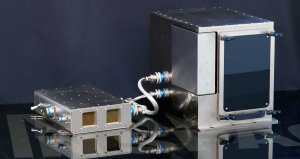It’s official! A 3D printer has made it into space! Last weekend, the uncrewed Dragon spacecraft from Space X was loaded up with 5,000 pounds of cargo, including one piece of baggage precious to those in the 3D printing community: the Made In Space Zero G Printer, a 3D printer specifically designed to operate in the absence of gravity. And, after a bit of a weather-related delay, the Dragon Capsule was launched from Cape Canaveral, Florida into the depths of space atop the Falcon 9 rocket on September 21, 2014 at 1:52 AM EDT:
Those following the story waited with baited breath until, after a two day journey, the Dragon Capsule arrived at the International Space Station on September 23, marking the first time that astronauts would be able to 3D print in space. This news is exciting for just about everyone who likes 3D printing, space, and human scientific and technological progress. Just look how excited the Made In Space crew, particularly their CEO Aaron Kemmer and CTO Jason Dunn, are watching the SpaceX CRS-4 launch:
If the importance of a 3D printer in space doesn’t seem immediately clear, you might be wondering how this came about and what the big deal is. The Zero G Printer is a project four years in the making, with the company’s founders attending Singularity University at the NASA Ames Research Center in the summer of 2010 and forming Made In Space with the intention of limiting the problems of shipping cargo from Earth to astronauts aboard the ISS and, one day, on other planets. Soon after, in 2011, the company’s proposal for a Zero-G 3D printer was accepted by NASA’s Flight Opportunities Program, meant to cultivate private spaceflight projects by offering businesses microgravity environments with which to test new technology.


Finally, last week, Made In Space made history, by sending their Zero G Printer to the ISS, where it will begin its official 3D printing tests. The machine will be extruding all sorts of objects, including test pieces, potential tools and replacement parts for the space station, cube satellites, and even some designs by K-12 students that win the Future Engineers Space Tool Challenge.
I’m pretty jaded when it comes to start-ups suggesting that their product will “disrupt” everything, but, as hyperbolic and cliched as it might sound, the Zero-G Printer arriving at the ISS really is “only the beginning”. In the short term, the Made In Space machine can produce tools on the ISS. Whether in the case of an Apollo 13-style emergency or run-of-the-mill astronaut activities, crew members will be able to manufacture, on demand, components critical or quotidian. According to the company, 30% of the spare parts currently aboard the ISS can be manufactured with their 3D printer. With a single shipment of filament, the space station would no longer need to await parts flown up to them, costing valuable weight and space on a given spacecraft that could be used for other items. As 3D printing technology improves, including the variety of materials, the potential for what types of object can be printed will increase the usefulness of a printer in space greatly.
In the long run, the next generation of Mars rover could 3D print its own tools or replacement pieces, potentially even electronic components. Not long after that, a 3D printer in space could pave the way for constructing habitats on other planetary bodies, where it could then be used to manufacture necessary tools and supplies. And, if the technology is capable of using surrounding materials – as multiple researchers, including Made In Space, have demonstrated with simulated moon rock – the need for future material shipments would be greatly reduced. As the company’s CEO, Aaron Kemmer, said in a recent press release:
This is more than a 3D printer. It’s more than a machine shop in space. It’s a landmark for humanity. For the first time in the history of our species, we will be manufacturing tools and hardware away from the Earth. Now that we’ve made this breakthrough, the sky is no longer the limit for additive manufacturing – the era of off-world manufacturing has begun.
Having been the first company to put a 3D printer into space, it’s important not to take this sort of statement with a grain of salt. When Made In Space makes a bold claim, they might just mean it.


